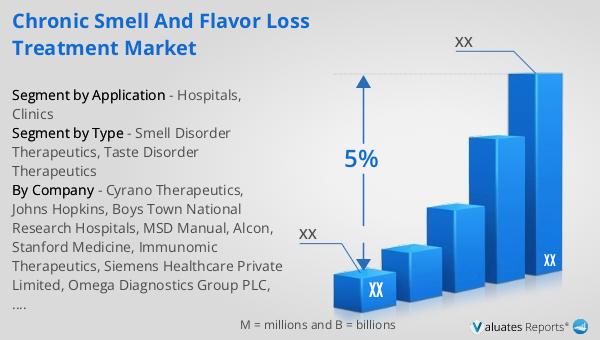What is Global Chronic Smell and Flavor Loss Treatment Market?
The Global Chronic Smell and Flavor Loss Treatment Market is a specialized sector within the broader healthcare and pharmaceutical industry. This market focuses on developing and providing treatments for individuals who suffer from chronic loss of smell (anosmia) and taste (ageusia). These conditions can significantly impact a person's quality of life, affecting their ability to enjoy food, detect hazards like smoke or gas leaks, and even their overall mental health. Treatments in this market range from medications and nasal sprays to more advanced therapies like olfactory training and regenerative medicine. The market is driven by increasing awareness of these conditions, advancements in medical research, and a growing aging population, which is more susceptible to sensory loss. Additionally, the COVID-19 pandemic has brought more attention to smell and taste disorders, as these are common symptoms of the virus, further fueling the demand for effective treatments. The market is highly competitive, with numerous pharmaceutical companies, research institutions, and healthcare providers working to develop innovative solutions to address this growing health concern.

Smell Disorder Therapeutics, Taste Disorder Therapeutics in the Global Chronic Smell and Flavor Loss Treatment Market:
Smell Disorder Therapeutics and Taste Disorder Therapeutics are two critical components of the Global Chronic Smell and Flavor Loss Treatment Market. Smell Disorder Therapeutics focuses on treatments for conditions like anosmia, hyposmia (reduced ability to smell), and parosmia (distorted sense of smell). These treatments often include corticosteroids, which help reduce inflammation in the nasal passages, and nasal saline irrigations to clear out any blockages. More advanced therapies involve olfactory training, where patients are exposed to various scents over time to help retrain their sense of smell. In some cases, surgical interventions may be necessary to remove obstructions or repair damage to the olfactory system. On the other hand, Taste Disorder Therapeutics addresses conditions like ageusia, hypogeusia (reduced ability to taste), and dysgeusia (distorted sense of taste). Treatments for taste disorders often involve addressing underlying causes such as nutritional deficiencies, infections, or side effects of medications. Zinc supplements are commonly used, as zinc is essential for maintaining a healthy sense of taste. In some cases, medications that stimulate saliva production can help, as a dry mouth can exacerbate taste disorders. Both smell and taste disorder therapeutics are continually evolving, with ongoing research into new medications, therapies, and even regenerative medicine techniques that aim to restore lost sensory functions. The integration of technology, such as virtual reality and artificial intelligence, is also being explored to enhance treatment outcomes. Overall, the Global Chronic Smell and Flavor Loss Treatment Market is a dynamic and rapidly growing field, driven by the need to improve the quality of life for individuals affected by these sensory disorders.
Hospitals, Clinics in the Global Chronic Smell and Flavor Loss Treatment Market:
The usage of treatments from the Global Chronic Smell and Flavor Loss Treatment Market is particularly prominent in hospitals and clinics. Hospitals, being large healthcare institutions, often have specialized departments and resources dedicated to diagnosing and treating sensory disorders. Patients with chronic smell and flavor loss may be referred to otolaryngologists (ear, nose, and throat specialists) or neurologists for comprehensive evaluations. Hospitals are equipped with advanced diagnostic tools such as MRI and CT scans, which can help identify underlying causes of sensory loss, such as tumors, infections, or neurological conditions. Treatment plans in hospitals may include a combination of medications, olfactory training, and in some cases, surgical interventions. Additionally, hospitals often participate in clinical trials, providing patients access to cutting-edge treatments and therapies that are not yet widely available. Clinics, on the other hand, offer a more accessible and often more personalized approach to treating smell and taste disorders. Patients can visit clinics for initial consultations, follow-up appointments, and ongoing management of their conditions. Clinics may provide a range of services, from prescribing medications and supplements to offering olfactory training sessions. They also play a crucial role in patient education, helping individuals understand their conditions and how to manage them effectively. Both hospitals and clinics are essential in the Global Chronic Smell and Flavor Loss Treatment Market, working together to ensure that patients receive comprehensive and effective care. The collaboration between these healthcare settings helps to streamline the diagnosis and treatment process, making it easier for patients to access the care they need.
Global Chronic Smell and Flavor Loss Treatment Market Outlook:
The global pharmaceutical market was valued at 1,475 billion USD in 2022 and is projected to grow at a compound annual growth rate (CAGR) of 5% over the next six years. In comparison, the chemical drug market saw an increase from 1,005 billion USD in 2018 to 1,094 billion USD in 2022. This growth highlights the expanding demand for pharmaceutical products and the continuous advancements in drug development and healthcare solutions. The pharmaceutical market encompasses a wide range of products, including prescription medications, over-the-counter drugs, and biologics, all aimed at improving health outcomes and quality of life. The chemical drug market, a subset of the broader pharmaceutical industry, focuses specifically on chemically synthesized medications. The steady growth in both markets underscores the importance of ongoing research and development, regulatory support, and the increasing need for effective treatments across various medical conditions.
| Report Metric | Details |
| Report Name | Chronic Smell and Flavor Loss Treatment Market |
| CAGR | 5% |
| Segment by Type |
|
| Segment by Application |
|
| By Region |
|
| By Company | Cyrano Therapeutics, Johns Hopkins, Boys Town National Research Hospitals, MSD Manual, Alcon, Stanford Medicine, Immunomic Therapeutics, Siemens Healthcare Private Limited, Omega Diagnostics Group PLC, HYCOR Biomedical |
| Forecast units | USD million in value |
| Report coverage | Revenue and volume forecast, company share, competitive landscape, growth factors and trends |
